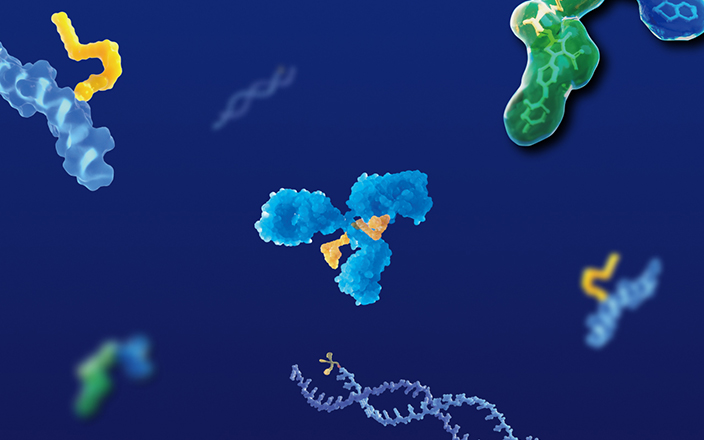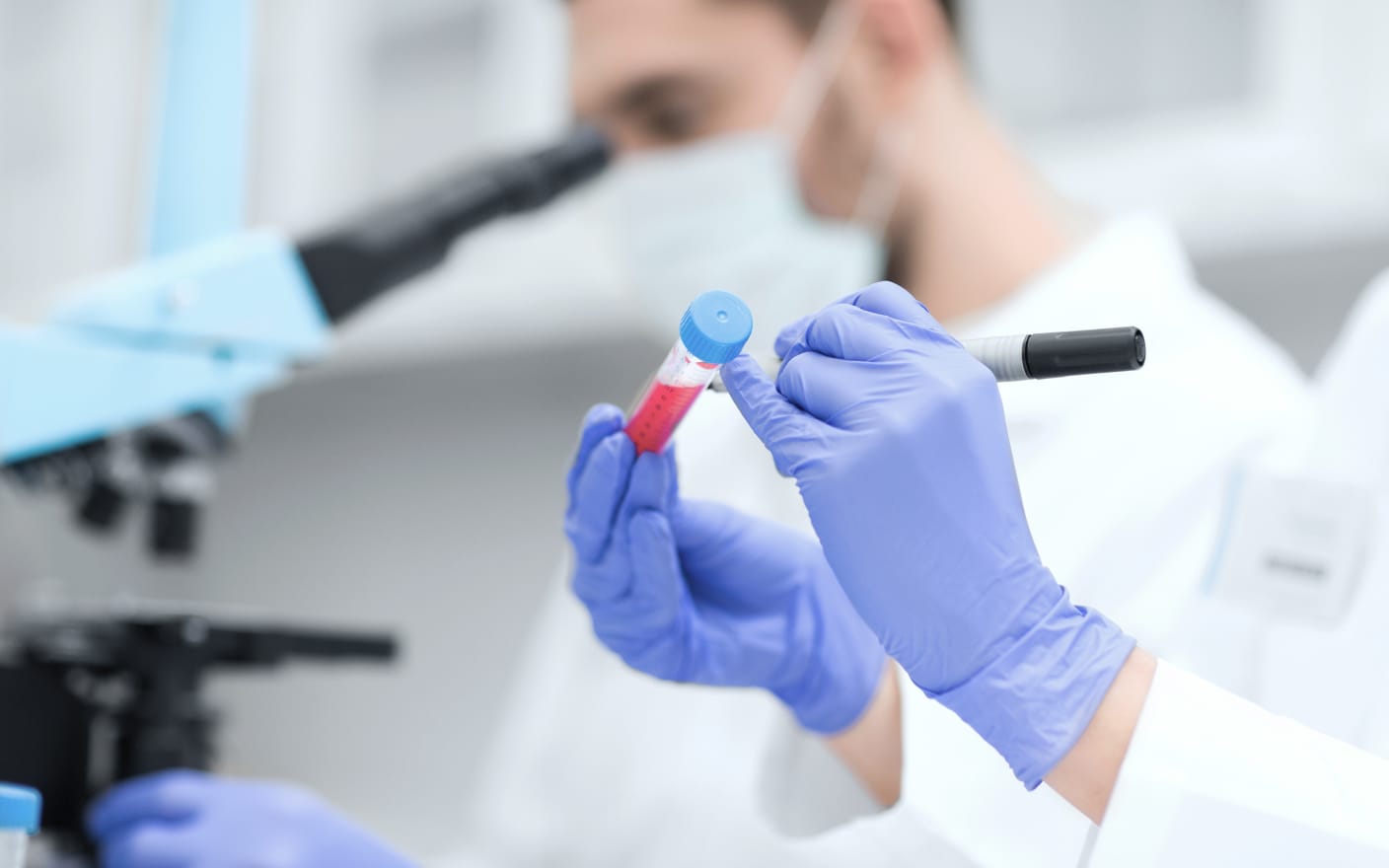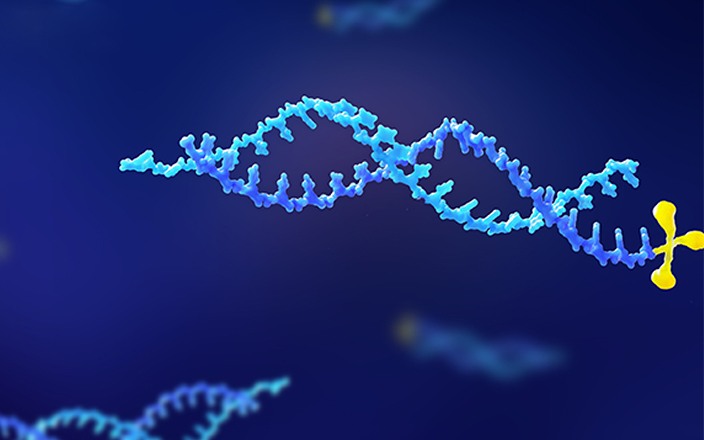Recently, research and development (R&D), production, and commercialization of oligonucleotides have rapidly developed because of their unique advantages in gene expression regulation. A global data search revealed that 17 oligonucleotide drugs were approved between 1998 and 2023, and more than 100 phase II or III clinical trials of oligonucleotides are ongoing. These oligonucleotides target 66 genes and are approved or under investigation for 102 different indications covering 14 therapeutic areas 1. Similar to traditional small molecule drugs, in vitro and in vivo metabolism studies in animals are crucial for identifying the drug efficacy of oligonucleotide drug and providing information about the metabolic pathways and products during the preclinical study phase of drug development. Currently, in vitro and in vivo metabolism studies as part of application materials of all approved oligonucleotide drugs were submitted to elucidate the metabolic behavior and excretion pathways. This article focuses on metabolizing enzymes, metabolic behavior, in vitro and in vivo metabolic research strategies, and metabolite profiling and identification methods of oligonucleotide, offers references for novel oligonucleotide drug development.
Metabolism Studies and Metabolite Profiling and Identification of Oligonucleotide Drugs
(1) Metabolic enzymes and metabolic pathway
Oligonucleotide drugs are metabolized and degraded into shortmers by exonucleases or endonucleases. First-generation antisense oligonucleotides (ASOs) with phosphorothioate backbone modification are metabolized into shortmers mainly by cleavage from the 3' end by exonucleases in the blood. Besides, these ASOs are mainly cleaved from both ends from outside to inside by 3' and 5' exonucleases in tissues. Second-generation ASOs usually feature the phosphorothioate backbone in the middle and the non-phosphorothioate backbone containing 2'-O modified gapmer at both ends. These compounds are cleaved in the middle by endonucleases in tissues and then further cleaved into small fragments by exonucleases.
The metabolism of the sense and antisense strands of the N-acetylgalactosamine (GalNAc) conjugated small interfering RNA (siRNA) is disparate. Specifically, the antisense strand is cleaved and metabolized into shortmers by exonuclease, while the sense strand is primary metabolized and detached from GalNAc and the linker followed by being metabolized into shortmers by exonuclease (Figure 1) 3.

Figure 1. Schema of ASO and GalNAc-siRNA metabolic pathways 3,4
(2) Strategies and methods for metabolic study of oligonucleotides
Over the past two decades, study models for the metabolism of approved and investigational oligonucleotide drugs have changed. They have evolved from the earliest in vivo assay on target tissues, plasma, and urine to the recent in vitro incubation assay with cells, microsomes, S9, plasma or serum, and plasma, urine, feces, and target tissues after in vivo administration. Scientists are still exploring a more scientific, rational, and comprehensive approach to metabolism studies. Extensive studies have shown that the metabolic stability of oligonucleotides under the presence of hydrolytic enzymes in the blood can be investigated by incubation in plasma or serum in vitro. Similarly, the metabolic behavior of oligonucleotides in target tissues in vivo can be assessed by the incubation of tissue S9 fractions. Additionally, metabolite profiling using human in vitro models such as tissue homogenates, subcellular fractions (e.g., S9) facilitates the development of methods for qualitative/quantitative analysis of clinical in vivo metabolites 2.
(3) Strategies for in vitro and in vivo metabolism studies of oligonucleotides
The in vitro metabolite identification of oligonucleotides in different species can obtain the metabolic difference cross species, which can be compared with the in vivo metabolic data of animals. These findings could be used to obtain correlation speculations between in vitro and in vivo metabolism, and thus find suitable animal species with metabolic behaviors closely resembling those of humans. Common in vitro metabolic models for oligonucleotide include plasma, S9, and tissue homogenates. For example, for the liver-targeted oligonucleotide, liver S9 can be used for metabolic stability and metabolite identification. Preclinical in vivo metabolism studies mainly focus on metabolite identification and quantitative bioanalysis of plasma, urine, feces, and target tissues (such as liver or kidney, etc.) in animals (Table 1).
|
Assays |
Biological matrices |
Target analytes |
|
|
In vitro |
Metabolic stability |
Plasma, S9, and tissue homogenate |
Oligonucleotide drugs |
|
Metabolite identification |
Plasma, S9, and tissue homogenate |
Oligonucleotide drugs and metabolites |
|
|
In vivo |
Metabolite identification |
Plasma, urine, feces, and target tissue |
Oligonucleotide drugs and metabolites |
|
PK/TK |
Plasma and tissue |
Oligonucleotide drugs and high proportion metabolites |
Table 1. Strategies for in vitro and in vivo metabolic studies of oligonucleotides
PK: Pharmacokinetics; TK: Toxicokinetics
The WuXi AppTec DMPK metabolite identification (MetID) team has been exploring methods to study the in vitro and in vivo metabolism of oligonucleotides in recent years. At the beginning of establishment of oligonucleotide metabolism research platform, the research methods of oligonucleotide drugs were fully investigated for more than two decades. The team has evaluated and verified the research systems for oligonucleotide drugs through continuously optimizing various conditions.
(4) Analytical methods for oligonucleotide metabolite identification studies
At present, the main bioanalytical methods for oligonucleotides include liquid chromatography–ultraviolet (LC–UV), LC–tandem mass spectrometry (LC-MS/MS), immunocapture hybridization meso scale discovery (MSD), enzyme-linked immunosorbent assay (ELISA), LC-fluorescence (LC-FL), and quantitative reverse transcription–polymerase chain reaction (qRT–PCR). Among these methods, LC–UV, LC-MS/MS, and LC–FL can be utilized for metabolite profiling. High resolution mass spectrometry (HRMS), based on high resolution, sensitivity, specificity, and mass accuracy, is an effective method for the qualitative or quantitative analysis of unknown metabolites using full mass scan and multiple mode scans.
The combination of HRMS and LC–UV has the significant advantage in the analysis and detection of oligonucleotides and their metabolites. The team has equipped the oligonucleotide metabolism research platform with a dedicated ultrahigh performance UPLC–UV–HRMS instrument for relevant analysis and detection. According to the study conditions in the literature and comparison with published results 5 (Table 2), additional low concentration metabolites were identified in addition to the metabolites reported in the literature through our highly sensitive HRMS and refined analytical techniques.
|
WuXi AppTec DMPK |
Literature |
||
|
Oligo 1 |
Oligo 3 |
Oligo 1 |
Oligo 3 |
|
Full-length |
Full-length |
/ |
Full-length |
|
3' n–1 |
3' n–1 |
3' n–1 |
3' n–1 |
|
3' n–2 |
3' n–2 |
3' n–2 |
3' n–2 |
|
3' n–3 |
3' n–3 |
3' n–3 |
3' n–3 |
|
3' n–4 |
3' n–4 |
3' n–4 |
3' n–4 |
|
3' n–5 |
3' n–10 |
3' n–5 |
|
|
3' n–6 |
3' n–15 |
3' n–6 |
|
|
3' n–7 |
5' n–1 |
3' n–7 |
|
|
3' n–8 |
5' n–2 |
3' n–8 |
|
|
3' n–9 |
5' n–3 |
3' n–9 |
|
|
3' n–10 |
|||
|
3' n–11 |
|||
|
3' n–12 |
|||
|
3' n–13 |
|||
Table 2. Comparison of oligonucleotides metabolite identification
Challenges and Solutions of Oligonucleotide Analysis
★ Sample pretreatment
The conventional sample processing methods include protein precipitation, liquid–liquid extraction (LLE), and solid phase extraction (SPE). Because of unique structural characteristics, oligonucleotide drugs have a high protein binding rate. Although the protein precipitation method is simple, its recovery is low with obvious endogenous matrix interference; thus, it is not recommended. LLE, SPE, or a combination of both are generally used to obtain higher recovery and reduce the effect of matrix interference.
-
LLE method: Phenol–chloroform–isoamyl alcohol is commonly employed as an extractant to remove organic substances such as proteins and phospholipids. According to the compound properties, the pH is adjusted to improve the oligonucleotide solubility in the aqueous phase, such as by adding ammonia.
-
SPE method: This is the most common method for oligonucleotide drugs extraction from biological matrices. After adding the sample to a fully activated SPE column or plate, the interfering substances, such as proteins, are washed with the washed solution, and then the oligonucleotide-related components are subsequently eluted by eluted solution for LC-MS/MS analysis (Figure 2) 6.
In addition, oligonucleotides usually non-specifically bind to polypropylene tubes/plates or glass containers. Therefore, it is vital to select appropriate consumables such as low-binding pipette tips, centrifuge tubes, and sample plates during sample processing to reduce the inaccuracy of study results.
★ LC-MS/MS sample analysis
Oligonucleotides are highly polar compounds, making it difficult to obtain good peak shapes using conventional reversed-phase chromatography. Therefore, ion-pair reversed-phase, hydrophilic interaction, and ion-exchange chromatography are commonly used, among which the most common method is ion-pair reversed-phase chromatography. It mainly uses amines such as triethylamine, N,N-diisopropylethylamine and triethylammonium acetate, and hexafluoroisopropanol to form ion-pair reagents.

Figure 2. Flow of assay procedure of bioanalysis and metabolite identification of oligonucleotides 6,7
LC-MS/MS Data Analysis and Metabolite Identification
Information about oligonucleotides, their metabolites, and other impurities can be obtained using HRMS full MS scan and MS2 scan (Full MS/data-dependent MS2 [ddMS2]). The metabolite profiling and identification, chemical modification positions and sequence confirmation of oligonucleotides require professional software, such as BioPharma Finder and ProMass. The following structural identification results (Figures 3 and 4) are obtained after analyzing HRMS data of an ASO (Oligo 25) and its metabolite 3′ n-1 using BioPharma Finder.

Figure 3. MS2 spectrum (B) of ASO and its structural fragment coverage map (A)

Figure 4. MS2 spectrum(D) of ASO metabolite 3'n-1 and its structural fragment coverage map (C)
Next, this article presents a case of the in vitro and in vivo metabolite profiling and identification study of oligonucleotides:
UPLC–UV–HRMS was used for the metabolite profiling and identification of Oligo A in in vitro incubated liver S9 and in monkey liver after 4 weeks of repeat administration to Cynomolgus monkey. The results showed the major metabolites in liver S9 in vitro were well matched with that in liver samples in vivo (Figure 5, Table 3). The in vivo metabolism can be predicted from the in vitro liver S9 metabolite identification results, which can provide the basis for developing suitable methods for in vivo metabolic studies. Figure 6 illustrates the metabolic pathway of Oligo A in liver S9 after incubation for 48 hours and in the liver of Cynomolgus monkeys after 4 weeks of repeated administration.

Figure 5. LC–UV metabolite profile of Oligo A in liver S9 fractions after incubation for 48 hours
|
Code |
Metabolic Change |
In Vitro : Liver S9 Fractions |
In Vivo : Liver |
||||
|
Mouse |
Rat |
Dog |
Monkey |
Human |
Monkey |
||
|
M1 |
SS_3'n-1 |
ND |
ND |
★ |
ND |
ND |
ND |
|
M2 |
SS-(3GalNAc_linker) |
ND |
ND |
ND |
★ |
★ |
★ |
|
M3 |
SS-GalNAc & 5' n-1) |
ND |
ND |
★ |
★ |
★ |
ND |
|
SS |
SS |
★ |
★ |
★ |
★ |
★ |
★ |
|
M4 |
SS-GalNAc |
★ |
★ |
★ |
★ |
★ |
ND |
|
M5 |
SS-2GalNAc |
★ |
★ |
★ |
ND |
★ |
ND |
|
M6 |
SS-3GalNAc |
★ |
★ |
★ |
★ |
★ |
★ |
|
M7 |
AS_3' n-2 |
ND |
ND |
ND |
ND |
ND |
★ |
|
M8 |
AS_3' n-1 |
★ |
★ |
★ |
★ |
★ |
★ |
|
AS |
AS |
★ |
★ |
★ |
★ |
★ |
★ |
Table 3. In vitro and in vivo metabolite identification of Oligo A
★: Detected; ND: Not detected

Figure 6. Schema of metabolic pathway of Oligo A in in vitro liver S9 after 48 h incubation and liver of Cynomolgus monkeys after 4 weeks of repeated administration.
Using HRMS and professional software, we have established a platform for metabolic studies and metabolite identification of oligonucleotides (ASO and siRNA) in in vitro incubation systems (such as plasma, liver S9, and liver homogenates) and in vivo biological samples (such as plasma, urine, feces, bile, CSF, brain, liver, and kidney, etc.) in animals. The platform has facilitated oligonucleotide drug R&D of several biopharmaceutical companies worldwide, completing more than 100 preclinical screening and IND applications.
The metabolite identification team has the capability to perform metabolite profiling and identification of oligonucleotides, analyze and confirm the chemical structure sequence of oligonucleotides (SS and AS of patisiran in Figure 7), which is beneficial to rule out mismatched structures based on assay results.

Figure 7. Sequence fragment coverage mapping of oligonucleotides
Conclusion
Metabolite profiling and identification is essential for oligonucleotide PK, TK, and drug clinical safety assessment in clinical trials. WuXi AppTec DMPK MetID team has established a research platform based on UPLC-UV-HRMS technology for metabolite profiling and identification of oligonucleotide. This platform provides high-quality metabolite profiling and identification of oligonucleotide, facilitating the rapid advancement of oligonucleotide drug development for global clients.
Click here to learn more about the strategies for OLIGO, or talk to a WuXi AppTec expert today to get the support you need to achieve your drug development goals.
Authors: Gengyao Qin, Weiqun Cao
Committed to accelerating drug discovery and development, we offer a full range of discovery screening, preclinical development, clinical drug metabolism, and pharmacokinetic (DMPK) platforms and services. With research facilities in the United States (New Jersey) and China (Shanghai, Suzhou, Nanjing, and Nantong), 1,000+ scientists, and over fifteen years of experience in Investigational New Drug (IND) application, our DMPK team at WuXi AppTec are serving 1,500+ global clients, and have successfully supported 1,200+ IND applications.
Reference
[1] Lara Moumné, et al. Oligonucleotide therapeutics: from discovery and development to patentability. Pharmaceutics 2022, 14, 260. http://doi.org/10.3390/pharmaceutics14020260
[2] Anna Kilanpwska, et al. In vivo and in vitro studies of antisense oligonucleotides – a review. RSC Adv., 2020, 10, 34501-34516.
[3] Basiri, B. et al. Introducing an In Vitro Liver Stability Assay Capable of Predicting the In Vivo Pharmacodynamic Efficacy of siRNAs for IVIVC. Molecular Therapy Nucleic Acids, 2020, 21, 725–736.
[4] http://www.toxicology.org/groups/rc/NorCal/docs/2010Spring/2010_3ToxConsider_OligonucleotideTherap.pdf
[5] Jaeah Kim, et al. In vitro metabolism of 2‘-ribose unmodified and modified phosphorothioate oligonucleotide therapeutics using liquid chromatography mass spectrometry. Biomedical Chromatography. 2020, 34, e4839. http://doi.org/10.1002/bmc.4839
[6] Łukasz Nuckowski, et al. Review on sample preparation methods for oligonucleotides analysis by liquid chromatography. Journal of Chromatography B 2018, 1090, 90-100.
[7] http://www.sigmaaldrich.com/technical-documents/articles/biology/custom-dna-oligos-qc-analysis-by-mass-spectrometry.html
Related Services and Platforms




-

 MetID (Metabolite Profiling and Identification)Learn More
MetID (Metabolite Profiling and Identification)Learn More -

 Novel Drug Modalities DMPK Enabling PlatformsLearn More
Novel Drug Modalities DMPK Enabling PlatformsLearn More -

 In Vitro MetID (Metabolite Profiling and Identification)Learn More
In Vitro MetID (Metabolite Profiling and Identification)Learn More -

 In Vivo MetID (Metabolite Profiling and Identification)Learn More
In Vivo MetID (Metabolite Profiling and Identification)Learn More -

 Metabolite Biosynthesis and Structural CharacterizationLearn More
Metabolite Biosynthesis and Structural CharacterizationLearn More -

 Metabolites in Safety Testing (MIST)Learn More
Metabolites in Safety Testing (MIST)Learn More -

 PROTAC DMPK ServicesLearn More
PROTAC DMPK ServicesLearn More -

 ADC DMPK ServicesLearn More
ADC DMPK ServicesLearn More -

 Oligo DMPK ServicesLearn More
Oligo DMPK ServicesLearn More -

 PDC DMPK ServicesLearn More
PDC DMPK ServicesLearn More -

 Peptide DMPK ServicesLearn More
Peptide DMPK ServicesLearn More -

 mRNA DMPK ServicesLearn More
mRNA DMPK ServicesLearn More -

 Covalent Drugs DMPK ServicesLearn More
Covalent Drugs DMPK ServicesLearn More
Stay Connected
Keep up with the latest news and insights.

















